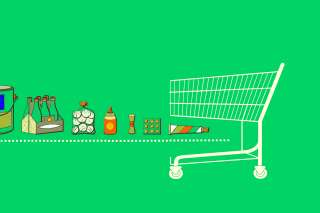Is Grocery Shopping Safe During the Coronavirus Outbreak? Here's What Experts Say

In a typical week, Americans go about getting groceries at the store or via delivery apps. But this is hardly a typical week.
Amid growing concerns about the coronavirus outbreak, people are being asked to avoid crowds and limit human contact. And the Centers for Disease Control and Prevention released a set of mitigation guidelines, suggesting households consider keeping a two-week supply of “food and other essentials" on hand. But how do you go about getting that into your home while maintaining social distance?
Grocery delivery services seem like the obvious choice, but their surge in popularity has led to sold-out items, a shortage of delivery times for weeks out, and (if you do manage to get a time slot) hours-long delays on scheduled deliveries.
Fortunately, going to a grocery store can be a safe and socially responsible option for most people — as long as you’re careful with your hands.
“What we're promoting is minimal contact of foreign objects between people,” says Dr. Jack Caravanos, a Certified Industrial Hygienist and a Clinical Professor of Environmental Public Health at NYU. For younger, healthy people, he says, “the transmission within the shopping experience is probably very low.”
He adds that for high-risk groups like seniors and those with preexisting conditions, grocery shopping is “an unnecessary risk" that can be avoided by letting someone do the shopping for them. But for the general public, it’s just a matter of taking the proper precautions.
Start off by choosing a time when there won’t be a lot of other people there — few enough to maintain the six feet of distance the CDC believes people should keep right now. Of course, that's going to be a tough call, given the constant influx of shoppers and the fear of missing out on what you need.
"We pretty much doubled and sometimes tripled in terms of traffic," said one manager of a popular supermarket who asked not to be named, because he said the company wouldn't appreciate it. "As soon as we put the product on the shelf, it’s getting wiped off. It’s hard to keep up, it really is."
So remember that most everyone will be trying to find the odd hours right now and you won't be able to rely on typical patterns. That means being careful with the ‘Popular times’ chart that pops up when you Google a location: If the wait time is shown in blue, it’s an average based on the last several weeks — relatively uninformative in these unique times. But live visit data, which shows up in pink and is indicated with the word “Live,” will tell you what’s happening right now (see here for visuals).
And early hours won't necessarily be your best bet in terms of getting the groceries you need.
"We’re asking customers not to arrive early, waiting in line for stores to open," Maria Brous, a spokesperson for Publix Super Markets, tells Money. "Since deliveries are made throughout the day, arriving first thing doesn’t guarantee product availability."
Instead, try calling ahead to ask an employee for some insight about lines and what items are and aren’t available, since the shelves are constantly being restocked. If you don’t like what you hear over the phone and you have access to a car, it might be in your best interest to leave your metro area.
“In an urban area, the ratio of food markets to people is so tight,” says Caravanos, who lives in New York City, where some grocery stores have been limiting the number of people to 15 to 20 people at a time. But if you venture out to the suburbs, there's often more availability. "There's plenty of food out there," he says. And no reason to wait out in the cold.
Before you leave
As you head out the door, it might be worth it to grab a few things that could make it a safer experience for yourself and for everyone you interact with:
- Disinfectant wipes or plain tissues to open doors or push a cart
- Your own pen to sign the receipt
- Reusable grocery bags
- A credit or debit card so you don’t have to exchange cash
Once you’re there
If you can handle the weight, use your reusable bag instead of pushing a cart. And consider choosing cans and other packaged items over loose produce that's possibly been picked up and put down over and over again. While experts say there is currently no evidence that the virus is spread through food, the CDC web site says it may be possible that a person can get COVID-19 by touching a surface or object that has the virus on it and then touching their own mouth, nose, or possibly their eyes.
"It's not the greenest practice that we want, but essentially in this day and age it's probably better to buy tomatoes that are pre-wrapped so that people don't handle them and then potentially contaminate them,” says Caravanos.
On that note, do your part and avoid touching multiple items before choosing what you want. And on your way out, be wary of the checkout counter, where — no matter how many precautions the store might take — the risk of touching shared items is highest.
At home, empty your containers, toss any wrappers, sanitize your hands, and wash your produce thoroughly.
Looking for money tips? Promoted:
5 Productive Things You Can Do While In Quarantine
Making Over $65K Per Year? Here Are 9 Smart Money Moves You Can Make Now
More from Money:
Coronavirus and Online Grocery Delivery: Everything You Need to Know
Can't Pay Your Credit Card Bill Because of Coronavirus? Here's What to Do
Stay Sane and Productive During the Coronavirus Crisis With This Expert-Curated Playlist